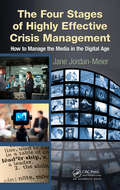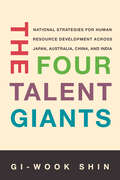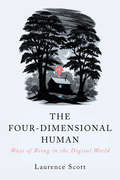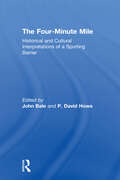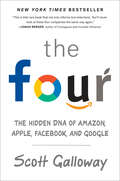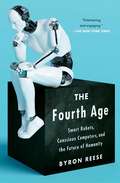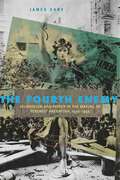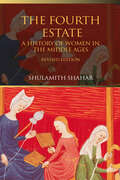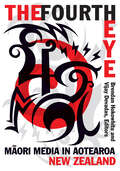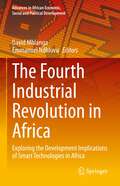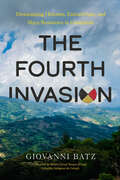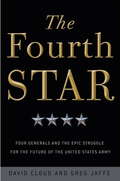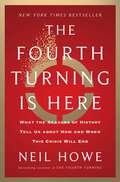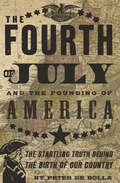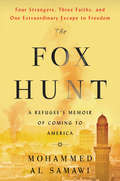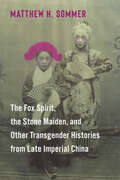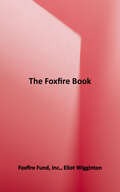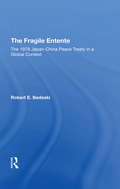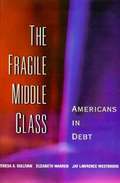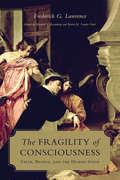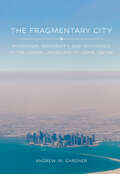- Table View
- List View
The Four Questions
by Lynne Sharon SchwartzWhy is this night different from all other nights?Every year when families gather for the Passover holiday, the youngest child poses that question as part of the poetic Four Questions near the start of the Seder. The answers are no less than the story of a people bound in slavery, their suffering in a foreign land, and their ultimate liberation – the story of Passover.Here the Four Questions are presented in breathtakingly luminous paintings by Ori Sherman. Whimsical animals parade through a unique format that can be read straight through in English or turned upside down to focus on the delicate Hebrew calligraphy and ingenious split-frame pictures. Each side of the Seder table can see its own variation of the richly colored scenes as elephants eat matzoh, monkeys dip herbs into water, and lions recline in newfound freedom. Author Lynne Sharon Schwartz answers the questions with refreshing clarity, providing insight into the symbols and rituals of the holiday.Experience a glorious art book, a beautiful book for the kids who find the afikomen, and a wonderful way to experience Passover and its unique celebration of freedom.
The Four Stages of Highly Effective Crisis Management: How to Manage the Media in the Digital Age
by Jane JordanFrom the Japanese tsunami and the Egyptian revolution to the Haitian earthquake and the Australian floods, social media has proven its power to unite, coalesce, support, champion, and save lives. Presenting cutting-edge media communication solutions, The Four Stages of Highly Effective Crisis Management explains how to choose the appropriate l
The Four Talent Giants: National Strategies for Human Resource Development Across Japan, Australia, China, and India (Studies of the Walter H. Shorenstein Asia-Pacific Research Center)
by Gi-Wook ShinThe Asia-Pacific region has seen extraordinary economic achievements. Japan's post-World War II transformation into an economic powerhouse challenging US dominance by the late 1980s was miraculous. China's rise as the world's second-largest economy is one of the 21st century's most stunning stories. India, now a top-five economy by GDP, is rapidly ascending. Despite its small population, Australia ranked among the top ten GDP nations in 1960 and has remained resilient. While cultivating, attracting, and leveraging talent has been crucial to growth in these countries, their approaches have varied widely, reflecting significant cultural, historical, and institutional differences. In this sweeping analysis of talent development strategies, Gi-Wook Shin investigates how these four "talent giants'' achieved economic power and sustained momentum by responding to risks and challenges such as demographic crises, brain drain, and geopolitical tensions. This book offers invaluable insights for policymakers and is essential for scholars, students, and readers interested in understanding the dynamics of talent and economic growth in the Asia-Pacific region and beyond.
The Four-Dimensional Human: Ways of Being in the Digital World
by Laurence ScottYou are a four-dimensional human. Each of us exists in three-dimensional, physical space. But, as a constellation of everyday digital phenomena rewires our lives, we are increasingly coaxed from the containment of our predigital selves into a wonderful and eerie fourth dimension, a world of ceaseless communication, instant information, and global connection. Our portals to this new world have been wedged open, and the silhouette of a figure is slowly taking shape. But what does it feel like to be four-dimensional? How do digital technologies influence the rhythms of our thoughts, the style and tilt of our consciousness? What new sensitivities and sensibilities are emerging with our exposure to the delights, sorrows, and anxieties of a networked world? And how do we live in public with these recoded private lives? Laurence Scott—hailed as a “New Generation Thinker” by the Arts and Humanities Research Council and the BBC—shows how this four-dimensional life is dramatically changing us by redefining our social lives and extending the limits of our presence in the world. Blending tech-philosophy with insights on everything from Seinfeld to the fall of Gaddafi, Scott stands with a rising generation of social critics hoping to understand our new reality. His virtuosic debut is a revelatory and original exploration of life in the digital age.
The Four-Minute Mile: Historical and Cultural Interpretations of a Sporting Barrier
by John BaleBreaking records and challenging the limits of human ability are central to much of our understanding of athletic track and field sports, with a world record title arguably as valued as an Olympic gold medal. Some particular limits and records take on greater significance, however, as in the case of the Four-Minute Mile which was roundly believed to be impossible until Roger Bannister shattered the illusion with half a second to spare in May 1954. These essays look at the background of Bannister’s achievement and the meaning that was ascribed to it by the media and the public at large, drawing on an array of interdisciplinary and international influences to unpick the legend surrounding an historic moment in our social and sporting past.
The Four: The Hidden DNA of Amazon, Apple, Facebook, and Google
by Scott Galloway<P>Amazon, Apple, Facebook, and Google are the four most influential companies on the planet. Just about everyone thinks they know how they got there. Just about everyone is wrong. <P>For all that’s been written about the Four over the last two decades, no one has captured their power and staggering success as insightfully as Scott Galloway. Instead of buying the myths these companies broadcast, Galloway asks fundamental questions. How did the Four infiltrate our lives so completely that they’re almost impossible to avoid (or boycott)? Why does the stock market forgive them for sins that would destroy other firms? And as they race to become the world’s first trillion-dollar company, can anyone challenge them? <P>In the same irreverent style that has made him one of the world’s most celebrated business professors, Galloway deconstructs the strategies of the Four that lurk beneath their shiny veneers. He shows how they manipulate the fundamental emotional needs that have driven us since our ancestors lived in caves, at a speed and scope others can’t match. And he reveals how you can apply the lessons of their ascent to your own business or career. Whether you want to compete with them, do business with them, or simply live in the world they dominate, you need to understand the Four. <P><b>A New York Times Bestseller</b>
The Fourth Age: Smart Robots, Conscious Computers, and the Future of Humanity
by Byron Reese&“The Fourth Age not only discusses what the rise of A.I. will mean for us, it also forces readers to challenge their preconceptions. And it manages to do all this in a way that is both entertaining and engaging.&” —The New York Times As we approach a great turning point in history when technology is poised to redefine what it means to be human, The Fourth Age offers fascinating insight into AI, robotics, and their extraordinary implications for our species.In The Fourth Age, Byron Reese makes the case that technology has reshaped humanity just three times in history: - 100,000 years ago, we harnessed fire, which led to language. - 10,000 years ago, we developed agriculture, which led to cities and warfare. - 5,000 years ago, we invented the wheel and writing, which lead to the nation state. We are now on the doorstep of a fourth change brought about by two technologies: AI and robotics. The Fourth Age provides extraordinary background information on how we got to this point, and how—rather than what—we should think about the topics we&’ll soon all be facing: machine consciousness, automation, employment, creative computers, radical life extension, artificial life, AI ethics, the future of warfare, superintelligence, and the implications of extreme prosperity. By asking questions like &“Are you a machine?&” and &“Could a computer feel anything?&”, Reese leads you through a discussion along the cutting edge in robotics and AI, and, provides a framework by which we can all understand, discuss, and act on the issues of the Fourth Age, and how they&’ll transform humanity.
The Fourth Enemy: Journalism and Power in the Making of Peronist Argentina, 1930–1955
by James CaneThe rise of Juan Perón to power in Argentina in the 1940s is one of the most studied subjects in Argentine history. But no book before this has examined the role the Peronists’ struggle with the major commercial newspaper media played in the movement’s evolution, or what the resulting transformation of this industry meant for the normative and practical redefinition of the relationships among state, press, and public. In The Fourth Enemy, James Cane traces the violent confrontations, backroom deals, and legal actions that allowed Juan Domingo Perón to convert Latin America’s most vibrant commercial newspaper industry into the region’s largest state-dominated media empire. An interdisciplinary study drawing from labor history, communication studies, and the history of ideas, this book shows how decades-old conflicts within the newspaper industry helped shape not just the social crises from which Peronism emerged, but the very nature of the Peronist experiment as well.
The Fourth Enemy: Journalism and Power in the Making of Peronist Argentina, 1930–1955
by James CaneThe rise of Juan Perón to power in Argentina in the 1940s is one of the most studied subjects in Argentine history. But no book before this has examined the role the Peronists’ struggle with the major commercial newspaper media played in the movement’s evolution, or what the resulting transformation of this industry meant for the normative and practical redefinition of the relationships among state, press, and public. In The Fourth Enemy, James Cane traces the violent confrontations, backroom deals, and legal actions that allowed Juan Domingo Perón to convert Latin America’s most vibrant commercial newspaper industry into the region’s largest state-dominated media empire. An interdisciplinary study drawing from labor history, communication studies, and the history of ideas, this book shows how decades-old conflicts within the newspaper industry helped shape not just the social crises from which Peronism emerged, but the very nature of the Peronist experiment as well.
The Fourth Estate: A History of Women in the Middle Ages
by Shulamith ShaharDid women really constitute a `fourth estate' in medieval society and, if so, in what sense? In this wide-ranging study Shulamith Shahar considers this and the whole question of the varying attitudes to women and their status in western Europe between the twelfth and the fifteenth centuries.
The Fourth Eye: Maori Media in Aotearoa New Zealand (Indigenous Americas)
by Brendan Hokowhitu Vijay DevadasFrom the signing of the Treaty of Waitangi between Indigenous and settler cultures to the emergence of the first-ever state-funded Māori television network, New Zealand has been a hotbed of Indigenous concerns. Given its history of colonization, coping with biculturalism is central to New Zealand life. Much of this &“bicultural drama&” plays out in the media and is molded by an anxiety surrounding the ongoing struggle over citizenship rights that is seated within the politics of recognition. The Fourth Eye brings together Indigenous and non-Indigenous scholars to provide a critical and comprehensive account of the intricate and complex relationship between the media and Māori culture. Examining the Indigenous mediascape, The Fourth Eye shows how Māori filmmakers, actors, and media producers have depicted conflicts over citizenship rights and negotiated the representation of Indigenous people. From nineteenth-century Māori-language newspapers to contemporary Māori film and television, the contributors explore a variety of media forms including magazine cover stories, print advertisements, commercial images, and current Māori-language newspapers to illustrate the construction, expression, and production of indigeneity through media.Focusing on New Zealand as a case study, the authors address the broader question: what is Indigenous media? While engaging with distinct themes such as the misrepresentation of Māori people in the media, access of Indigenous communities to media technologies, and the use of media for activism, the essays in this much-needed new collection articulate an Indigenous media landscape that converses with issues that reach far beyond New Zealand. Contributors: Sue Abel, U of Auckland; Joost de Bruin, Victoria U of Wellington; Suzanne Duncan, U of Otago; Kevin Fisher, U of Otago; Allen Meek, Massey U; Lachy Paterson, U of Otago; Chris Prentice, U of Otago; Jay Scherer, U of Alberta; Jo Smith, Victoria U of Wellington; April Strickland; Stephen Turner, U of Auckland.
The Fourth Industrial Revolution in Africa: Exploring the Development Implications of Smart Technologies in Africa (Advances in African Economic, Social and Political Development)
by David Mhlanga Emmanuel NdhlovuThis edited volume, the third in a three-volume set, discusses implications of The Fourth Industrial Revolution (4IR) in Africa. By rebuilding natural ecosystems, linking billions to digital networks, and better managing assets, the world may be able to undo the damage done by the industrial revolutions. There are, however, significant concerns that institutions will not be able to adapt, that governments will not adopt and regulate new technologies to reap their benefits, that power shifts will result in serious new security threats, that inequality will increase, and that societies will break apart. Written by an international panel of experts, analyzes the potential of smart technology across sectors and industries in Africa to bring about long-term, sustainable growth.
The Fourth Invasion: Decolonizing Histories, Extractivism, and Maya Resistance in Guatemala
by Giovanni BatzA free ebook version of this title is available through Luminos, University of California Press’s Open Access publishing program. Visit www.luminosoa.org to learn more. Based on more than a decade of ethnographic research, The Fourth Invasion examines an Ixil Maya community’s movement against the construction of one of the largest hydroelectric plants in Guatemala. The arrival of the Palo Viejo hydroelectric plant (built by the Italian corporation Enel Green Power) to the municipality of Cotzal highlighted the ongoing violence inflicted on Ixils by outsiders and the Guatemalan state. Locals referred to the building of the hydroelectric plant as the "new invasion" or "fourth invasion" for its similarity to preceding invasions: Spanish colonization, the creation of the plantation economy, and the state-led genocide during the Guatemalan armed conflict. Through a historical account of cyclical waves of invasions and resistance in Cotzal during the four invasions, Giovanni Batz argues that extractivist industries are a continuation of a colonial logic of extraction based on the displacement and destruction of Indigenous Peoples' territories and values that has existed since the arrival of the Spanish in 1524. The current movements in Cotzal, rooted in a long history of resistance, counter dominant narratives of Indigenous Peoples that often portray them as "conquered."
The Fourth Star: Four Generals and the Epic Struggle for the Future of the United States Army
by David Cloud Greg JaffeThey were four exceptional soldiers, a new generation asked to save an army that had been hollowed out after Vietnam. They survived the military's brutal winnowing to reach its top echelon. They became the Army's most influential generals in the crucible of Iraq. Collectively, their lives tell the story of the Army over the last four decades and illuminate the path it must travel to protect the nation over the next century. Theirs is a story of successes and failures, of ambitions achieved and thwarted, of the responsibilities and perils of command. The careers of this elite quartet show how the most powerful military force in the world entered a major war unprepared, and how the Army, drawing on a reservoir of talent that few thought it possessed, saved itself from crushing defeat against a ruthless, low-tech foe. In The Fourth Star, you'll follow:*Gen. John Abizaid, one of the Army's most brilliant minds. Fluent in Arabic, he forged an unconventional path in the military to make himself an expert on the Middle East, but this unique background made him skeptical of the war he found himself leading. *Gen. George Casey Jr., the son of the highest-ranking general to be killed in the Vietnam War. Casey had grown up in the Army and won praise for his common touch and skill as a soldier. He was determined not to repeat the mistakes of Vietnam but would take much of the blame as Iraq collapsed around him. *Gen. Peter Chiarelli, an emotional, take-charge leader who, more than any other senior officer, felt the sting of the Army's failures in Iraq. He drove his soldiers, the chain of command, and the U.S. government to rethink the occupation plans-yet rarely achieved the results he sought.*Gen. David Petraeus, a driven soldier-scholar. Determined to reach the Army's summit almost since the day he entered West Point, he sometimes alienated peers with his ambition and competitiveness. When he finally got his chance in Iraq, he-more than anyone-changed the Army's conception of what was possible. Masterfully written and richly reported, The Fourth Star ranges far beyond today's battlefields, evoking the Army's tumultuous history since Vietnam through these four captivating lives and ultimately revealing a fascinating irony: In an institution that prizes obedience, the most effective warriors are often those who dare to question the prevailing orthodoxy and in doing so redefine the American way of war.From the Hardcover edition.
The Fourth Turning Is Here: What the Seasons of History Tell Us about How and When This Crisis Will End
by Neil HoweThe visionary behind the bestselling phenomenon The Fourth Turning looks once again to America&’s past to predict our future in this startling and hopeful prophecy for how our present era of civil unrest will resolve over the next ten years—and what our lives will look like once it has. Twenty-five years ago, Neil Howe and the late William Strauss dazzled the world with a provocative new theory of American history. Looking back at the last 500 years, they&’d uncovered a distinct pattern: modern history moves in cycles, each one lasting roughly eighty to one hundred years, the length of a long human life, with each cycle composed of four eras—or &“turnings&”—that always arrive in the same order and each last about twenty years. The last of these eras—the fourth turning—was always the most perilous, a period of civic upheaval and national mobilization as traumatic and transformative as the New Deal and World War II, the Civil War, or the American Revolution. Now, right on schedule, our own fourth turning has arrived. And so Neil Howe has returned with an extraordinary new prediction. What we see all around us—the polarization, the growing threat of civil conflict and global war—will culminate by the early 2030s in a climax that poses great danger and yet also holds great promise, perhaps even bringing on America&’s next golden age. Every generation alive today will play a vital role in determining how this crisis is resolved, for good or ill. Illuminating, sobering, yet ultimately empowering, The Fourth Turning Is Here takes you back into history and deep into the collective personality of each living generation to make sense of our current crisis, explore how all of us will be differently affected by the political, social, and economic challenges we&’ll face in the decade to come, and reveal how our country, our communities, and our families can best prepare to meet these challenges head-on.
The Fourth World: An Indian Reality
by Michael Posluns George ManuelA foundational work of radical anticolonialism, back in print Originally published in 1974, The Fourth World is a critical work of Indigenous political activism that has long been out of print. George Manuel, a leader in the North American Indian movement at that time, with coauthor journalist Michael Posluns, presents a rich historical document that traces the struggle for Indigenous survival as a nation, a culture, and a reality. The authors shed light on alternatives for coexistence that would take place in the Fourth World—an alternative to the new world, the old world, and the Third World. Manuel was the first to develop this concept of the &“fourth world&” to describe the place occupied by Indigenous nations within colonial nation-states. Accompanied by a new Introduction and Afterword, this book is as poignant and provocative today as it was when first published.
The Fourth of July and the Founding of America and the Founding of America: The Startling Truth Behind the Birth of Our Country
by Peter De BollaA history of the holiday and an “elegant, ironic, brief but deeply researched meditation on what makes America America” (Financial Times). Holidays of all sorts are celebrated in the United States, many rooted in the country’s great diversity of ethnicities, religions, and cultures. But one day unites all Americans: the Fourth of July. Every year, Independence Day revelers mark the founding of the nation with picnics and parades, flag-waving and fireworks displays. But in fact, much of the inherited lore that surrounds the Fourth is myth and legend, not history. Even the date of the holiday is misleading, as the Declaration of Independence was in fact penned on the second of July. Jefferson did not write it himself, nor was it intended to mark the birth of a new nation. In this remarkable work of research and narrative, Peter de Bolla teases out the true story of the Fourth of July—and traces the holiday’s history from 1776 through the Civil War, the Cold War, and the present.
The Fox Hunt: A Refugee's Memoir of Coming to America
by Mohammed Al SamawiA refugee of Yemen's brutal civil war recounts his journey to freedom with the help of an online interfaith community: "a gripping account of terror and escape” (New York Times Book Review).Mohammed Al Samawi was raised to think of Christians and Jews as his enemy. But after secretly receiving a Bible at age twenty-three, he began connecting with interfaith activists on social media. He made it his mission to promote dialogue and cooperation in Yemen—a mission that drew death threats against him and his family. Mohammed fled to the port city of Aden, not knowing that it would soon become the battleground of a proxy war between Iran and Saudi Arabia. As gunfire and grenades exploded throughout the city, Mohammed hid in the bathroom of his apartment and desperately appealed to his contacts on Facebook. Miraculously, a handful of people he barely knew responded. Over thirteen days, four ordinary young people with no experience in diplomacy or military exfiltration worked across six technology platforms and ten time zones to save this innocent young man trapped between deadly forces— rebel fighters from the north and Al Qaeda operatives from the south. The Fox Hunt tells the story of a thrilling, improbable escape, and reminds us that goodness and decency can triumph in the darkest circumstances.A NAUTILUS BOOK AWARD WINNER A NATIONAL JEWISH BOOK AWARD FINALIST
The Fox Spirit, the Stone Maiden, and Other Transgender Histories from Late Imperial China
by Matthew H. SommerIn imperial China, people moved away from the gender they were assigned at birth in different ways and for many reasons. Eunuchs, boy actresses, and clergy left behind normative gender roles defined by family and procreation. “Stone maidens”—women deemed physically incapable of vaginal intercourse—might depart from families or marriages to become Buddhist or Daoist nuns. Anatomical males who presented as women sometimes took a conventionally female occupation such as midwife, faith healer, or even medium to a fox spirit. Yet they were often punished harshly for the crime of “masquerading in women’s attire,” suspected of sexual predation, even when they had lived peacefully in their communities for many years.Exploring these histories and many more, this book is a groundbreaking study of transgender lives and practices in late imperial China. Through close readings of court cases, as well as Ming and Qing fiction and nineteenth-century newspaper accounts, Matthew H. Sommer examines the social, legal, and cultural histories of gender crossing. He considers a range of transgender experiences, illuminating how certain forms of gender transgression were sanctioned in particular social contexts and penalized in others. Sommer scrutinizes the ways Qing legal authorities and literati writers represented and understood gender-nonconforming people and practices, contrasting official ideology with popular mentalities. An unprecedented account of China’s transgender histories, this book also sheds new light on a range of themes in Ming and Qing law, religion, medicine, literature, and culture.
The Foxfire Book: Hog Dressing, Log Cabin Building, Mountain Crafts and Foods, Planting by the Signs, Snake Lore, Hunting Tales, Faith Healing, Moonshining, and Other Affairs of Plain Living
by Inc. Foxfire FundFirst published in 1972, The Foxfire Book was a surprise bestseller that brought Appalachia's philosophy of simple living to hundreds of thousands of readers. Whether you wanted to hunt game, bake the old-fashioned way, or learn the art of successful moonshining, The Foxfire Museum and Heritage Center had a contact who could teach you how with clear, step-by-step instructions. This classic debut volume of the acclaimed series covers a diverse array of crafts and practical skills, including log cabin building, hog dressing, basket making, cooking, fence making, crop planting, hunting, and moonshining, as well as a look at the history of local traditions like snake lore and faith healing.
The Fragile Bridge: Paterson Silk Strike, 1913
by Steve GolinIn 1913 skilled and unskilled workers in the silk industry of Paterson, New Jersey, joined forces to strike for better wages and working conditions. The International Workers of the World, or IWW, supported the strike, as did a group of left-leaning artists and writers from New York's Greenwich Village. This highly unusual coalition of workers and intellectuals formed the "fragile bridge" of the title, culminating in a spectacular pageant portraying the strike, held in Madison Square Garden. This book tells the story of the strike in rich detail and shows how its ultimate failure led to the collapse of the IWW.
The Fragile Entente: The 1978 Japan-china Peace Treaty In A Global Context
by Robert E BedeskiBetween early 1978 and late 1980, power relationships in the Pacific region underwent historic transformation. Deng-Xiaoping, re-emerging as a key leader in the People's Republic of China, demonstrated pragmatism in domestic and foreign policy. Beijing negotiated a Peace and Friendship Treaty with Japan, apparently opening an era of Sino-Japanese economic cooperation. Moscow viewed this development with alarm, fearing it would lead to a three-way alliance including the United States. Meanwhile, Japan foreswore any military significance in closer links with the PRC, but by succumbing to the Chinese demand for inclusion of a treaty clause denouncing Soviet hegemony, became an involuntary participant in the Sino-Soviet conflict. In this environment, the Sino-Japanese treaty-- which might have been an innocuous footnote to postwar history--became an event marking a new phase in East Asian affairs. Dr. Bedeski draws on Chinese, Soviet, and Japanese sources to clarify the relationships among the wide range of events ensuing from the treaty and points to its relevance to a new era of Sino-Soviet relations. The irony of the Peace and Friendship Treaty, he concludes, is that_it probably was a catalyst of insecurity and hostility in the region and that it became an important event leading to the participation of non-Communist actors--Japan, the U.S., and NATO-- in the Sino-Soviet conflict
The Fragile Middle Class: Americans in Debt
by Elizabeth Warren Teresa A. Sullivan Jay Lawrence WestbrookThis book is about the middle class as viewed through the lens of bankruptcy. Since 1997, the number of American families filing for federal bankruptcy annually has exceeded one million. By most measures, those who file are members of the middle class -- a group that has long provided stability and vitality for the American economic system. This raises the troubling question: why, during the most remarkable period of prosperity in our history, are unprecedented numbers of Americans encountering such serious financial trouble?The authors of this important book analyze court records and demographic data on thousands of bankruptcy cases, as well as debtors' own poignant accounts of the reasons for their bankruptcies. For many middle-class Americans, the findings show, financial stability is fragile -- almost any setback can be disastrous. The erosion of job stability, divorce and family instability, the visible and invisible costs of medical care, the burden of home ownership, and the staggering weight of consumer debt financed with plastic combine to threaten the financial security of growing numbers of middle-class families. The authors view the bankruptcy process in the light of changing cultural and economic factors and consider what this may signify for the future of a large, secure, and dynamic middle class.
The Fragility of Consciousness: Faith, Reason, and the Human Good
by Frederick Lawrence Kevin Vander Schel Randall S. RosenbergFrederick G. Lawrence is the authoritative interpreter of the work of Bernard Lonergan and an incisive reader of twentieth-century continental philosophy and hermeneutics. The Fragility of Consciousness is the first published collection of his essays and contains several of his best known writings as well as unpublished work. The essays in this volume exhibit a long interdisciplinary engagement with the relationship between faith and reason in the context of the crisis of culture that has marked twentieth- and twenty-first century thought and practice. Frederick G. Lawrence, with his profound and generous commitment to the intellectual life of the church, has produced a body of work that engages with Heidegger, Gadamer, Habermas, Ricoeur, Strauss, Voegelin, and Benedict XVI among others. These essays also explore various themes such as the role of religion in a secular age, political theology, economics, neo-Thomism, Christology, and much more. In an age marked by social, cultural, political, and ecclesial fragmentation, Lawrence models a more generous way – one that prioritizes friendship, conversation, and understanding above all else.
The Fragmentary City: Migration, Modernity, and Difference in the Urban Landscape of Doha, Qatar
by Andrew M. GardnerAs Andrew M. Gardner explains in The Fragmentary City, in Qatar and elsewhere on the Arabian Peninsula, nearly nine out of every ten residents are foreign noncitizens. Many of these foreigners reside in the cities that have arisen in Qatar and neighboring states. The book provides an overview of the gulf migration system with its diverse migrant experiences. Gardner focuses on the ways that demography and global mobility have shaped the city of Doha and the urban characteristics of the Arabian Peninsula in general. Building on those migrant experiences, the book turns to the spatial politics of the modern Arabian city, exploring who is placed where in the city and how this social landscape came into historical existence. The author reflects on what we might learn from these cities and the societies that inhabit them. In The Fragmentary City, Andrew M. Gardner frames the contemporary cities of the Arabian Peninsula not as poor imitations of Western urban modernity, but instead as cities on the frontiers of a global, neoliberal, and increasingly urban future.

